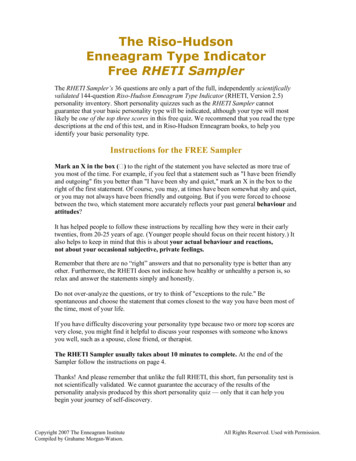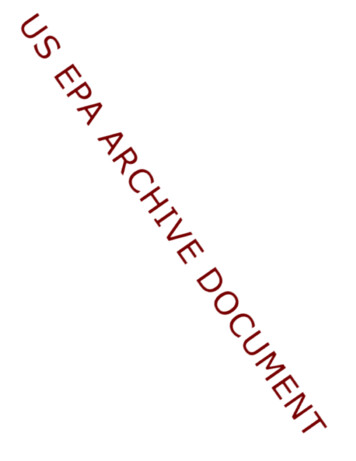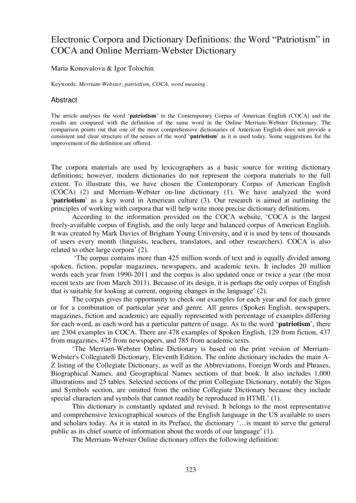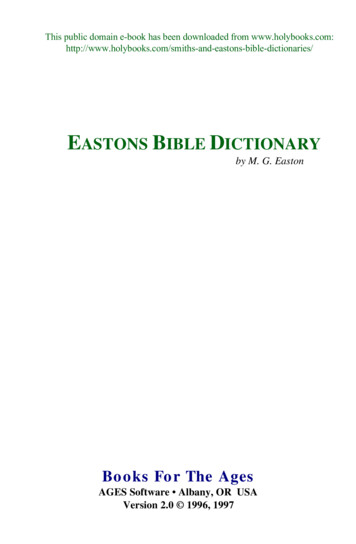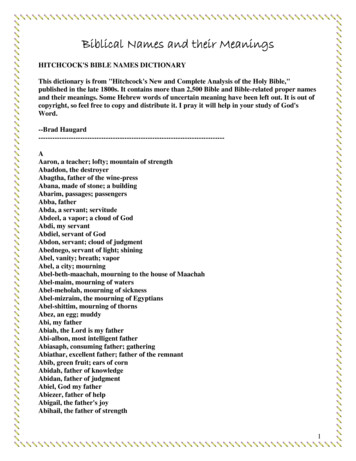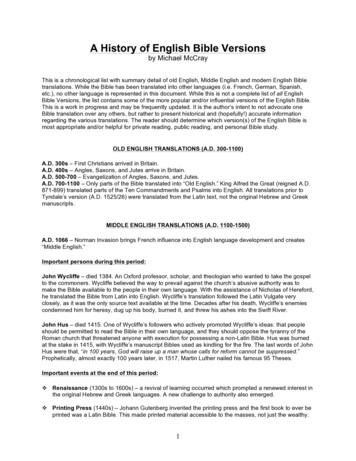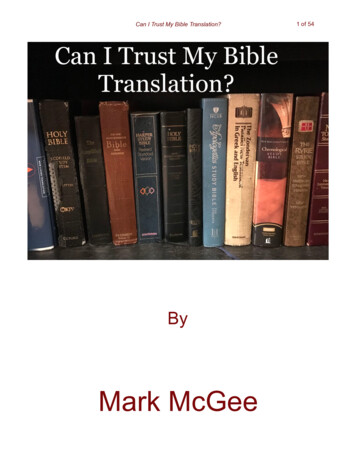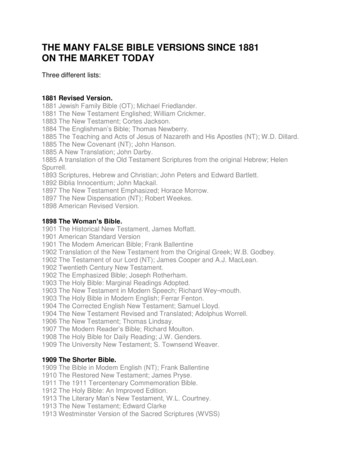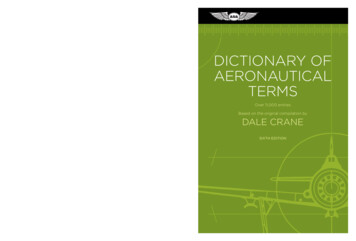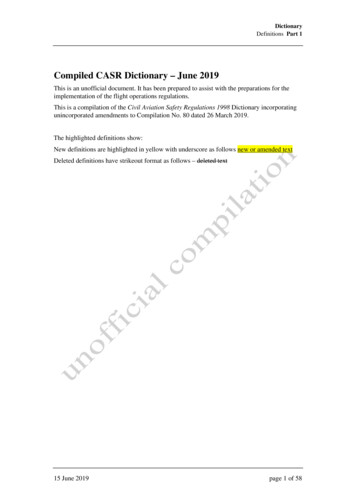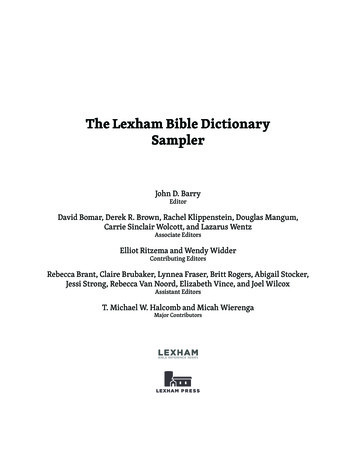
Transcription
The Lexham Bible DictionarySamplerJohn D. BarryEditorDavid Bomar, Derek R. Brown, Rachel Klippenstein, Douglas Mangum,Carrie Sinclair Wolcott, and Lazarus WentzAssociate EditorsElliot Ritzema and Wendy WidderContributing EditorsRebecca Brant, Claire Brubaker, Lynnea Fraser, Britt Rogers, Abigail Stocker,Jessi Strong, Rebecca Van Noord, Elizabeth Vince, and Joel WilcoxAssistant EditorsT. Michael W. Halcomb and Micah WierengaMajor Contributors
We would love to hear from you.Email us at editor@lexhampress.com or visit LexhamBibleDictionary.com.Copyright 2015 Lexham PressThis sample contains a selection of articles from the Lexham Bible Dictionary (Bellingham, WA: LexhamPress, 2012, 2013, 2014, 2015).Lexham Press, 1313 Commercial St., Bellingham, WA 98225LexhamPress.comUnless otherwise noted, Scripture quotations are from the Lexham English Bible (leb), copyright 2013 byLexham Press. Lexham is a registered trademark of Faithlife Corporation. Other Scripture translationsare used with permission and are abbreviated with each publisher’s preferred acronym; for copyrightinformation, see each individual translation.Acquisitions/Prodution: Scott Hausman, Rebekah Hurst, Jake Mailhot, Justin Marr, and Abby SalingerCover Design: Christine GerhartBook Design: Jahan Afshari
ContentsPreface1Overview Articles4Canon, New TestamentChristianityIsraelite ReligionGospels, SynopticTextual Criticism of the Hebrew Bible, MethodologyTextual Criticism of the New TestamentBiblical Book Entries49Exodus, Book ofExodus, Book of, Critical IssuesJohn, Gospel ofGalatians, Letter to theConcepts, People, and Place EntriesCreationSerpentYHWHJesus ChristDavid, King of IsraelPaul the ApostleJames, Son of ZebedeeJames, Son of AlphaeusJames, Father of JudasJames the LessConquest of CanaanJustificationCovenantLaw and the New TestamentWomen in the Bible95
Contextual Articles, Exploring Ancient TextsBible Background LiteratureDead Sea Scrolls, NonbiblicalDead Sea Scrolls, History of ResearchDead Sea Scrolls, IsaiahTemple ScrollGospel of JudasPseudepigraphaEnoch, Books ofEnoch, First Book ofTestaments of the Twelve Patriarchs167
PrefaceThe Lexham Bible Dictionary (LBD) is crafted fora broad audience: the pastor, the scholar, andthe curious explorer. LBD is an academic-levelresource, but entries always start by laying thefoundation for understanding. A curious explorermight need only the initial definition of an article,while a pastor might read half the entry and anacademic might mull over the entire article. LBDis designed to help you interact with the biblicaltext no matter what level of knowledge you havewhen you start. And as you grow in your study ofScripture, there will always be something new todiscover.VisionLexham Bible Dictionary is engaged with the bestand most recent scholarship and committed to theauthority of the Bible. This is a key tenet of theproject: to learn from and wrestle with the fullbreadth of biblical scholarship, while standing inthe rich tradition of the faith summarized by theancient Apostles’ and Nicene Creeds.ScopeThe Lexham Bible Dictionary includes: exhaustive coverage of biblical people, places,and events in their cultural contexts; detailed coverage of ancient texts and documents that influenced the Bible’s context; clear identification of every person, place, andancient document related to the Bible—resulting in one article per person, for example,rather than one article on multiple people whoshare the same name; deep exploration of the Bible’s context, textualdevelopment, and the process of canonization; academic-level content that is written to be accessible for anyone; a critical, unbiased approach to every entry, sothat readers can consider the interpretive options and make up their own minds.Lexham Bible Dictionary is your starting point forbiblical studies, from roughly 3,000 bc to ad 200.It also selectively covers topics from after ad 200when these documents, people, or events relate toresearch on the biblical text. This includes a bodyof articles that address ancient texts themselves—not only those that were deemed authoritative forthe Church through the process of canonization,but also many nonbiblical texts (up to the fourthcentury ad). These documents, such as the writings known as the Old Testament Pseudepigraphaand the New Testament Apocrypha, often surfacein discussions about biblical figures and ancientteachings. LBD also includes selected coverage ofthe church fathers insofar as they relate to pioneering biblical interpretation or the shape of thecanon.
Lexham Bible DictionaryCreating Lexham Bible DictionaryLexham Bible Dictionary is the product of collaboration with scholars from around the world. The dictionary comprises over 4.5 million words in morethan 7,000 articles by over 700 contributors froma wide variety of cultures and backgrounds—theequivalent of six encyclopedia-sized volumes inprint.Lexham Bible Dictionary was built using thetechnology and databases that power Logos BibleSoftware. By having a comprehensive database ofevery person and place in the Bible at our fingertips and the library and research power of LogosBible Software, we were able to create a trulyunique and thoroughly reviewed project. Whatused to take weeks, we could now do in minutes.This, combined with innovative project management and a very large number of contributors, accelerated the standard 10- to 15-year timeframe fora project like this to 5 years.Our editorial team sorted the entries into individual people, places, documents, events, andtypes of literature. In the process, we generatedover 4,500 short articles. For these entries ourmajor contributors and editors gathered commonknowledge into a concise reference format, oftenreworking data either from the Bible Knowledge Database that drives features of Logos BibleSoftware and/or from the public domain. For theapproximately 2,000 longer-form articles, individual contributors retained a certain amount offlexibility in matters like an article’s overall focus,areas of emphasis, and style of citing extrabiblicalresources.Lexham Press is committed to continually improving the Lexham Bible Dictionary. The digitaledition will stay up-to-date as scholarship movesforward and new discoveries are made.Using Lexham Bible DictionaryDesigned as a digital resource, LBD seamlesslyintegrates with Logos Bible Software. Each article contains links to all Scripture references,additional links to resources in the Logos BibleSoftware ecosystem, and even more links that arehand-curated to help connect you with relatedtopics and background material. Some of theselinks occur directly in the body text, while others2are included in a Related Articles section at theend of the entry.Lexham Bible Dictionary is easy to navigate:The digital data built into each article results in adictionary that can automatically suggest multipleequivalent terms/titles for any topic you’re searching for—and some data works behind the scenesto take you straight from the Bible text to the exactperson or place you’re looking up. Although otherbooks in the Logos Bible Software platform havesimilar functionality, LBD is the first resource builtfrom scratch with this technology in mind—making it more useful than any other dictionary inyour library.Lexham Bible Dictionary clearly identifies andlabels ancient documents related to the Bible,along with ancient literature written contemporaneously or in the earliest years of the canon’sreception. When applicable, entries explain howan ancient document was received throughouthistory and often suggest how to apply the particular writing to study of the Bible’s context. Inarticles overviewing specific types of literatureand historical and scholarly concepts, LBD definesthe relevant terminology, editorial approach, andcategorization methods used throughout the resource. These articles also cross-reference relatedarticles, either within the article itself or in a separate section at the end. The key entries that utilize this feature are: Jesus Christ Christianity Old Testament New Testament Manuscripts Bible, Texts and Versions of Canon, Overview of the Bible Background Literature Ancient Near Eastern Texts Israel, History of, Overview Semitic Languages Apocrypha, Old Testament Deuterocanonical Extrabiblical Pseudepigrapha, Old Testament Dead Sea Scrolls, Nonbiblical
Preface Early Christian Literature Apostolic Fathers Church Fathers Creeds and Confessions Apostles’ Creed Nicene Creed Rabbinic Literature Apocrypha, New Testament Nag Hammadi Codices Biblical CriticismThese entries are great places to get started, especially if you are new to the academic field of biblical studies.Our Hope for YouWhen we set out to create Lexham Bible Dictionaryin 2010, our primary goal was to develop the Bibledictionary we always wanted. We believed thata resource uniting scholarship and faith wouldmake God’s Word more approachable and moreunderstandable—all for the sake of Christ’s gospelreaching more people. Without a doubt, we haveseen God act on our behalf multiple times to bringthis project to fruition. He has shown His faithfulness time and again. We are grateful for the opportunity to present the Lexham Bible Dictionary to theChurch, and we hope that our efforts will lead youdeeper into the Bible and into friendship with itsAuthor.With much love for Christ and His work in allof us,John D. Barry, EditorOn behalf of the Lexham Bible Dictionary teamSummer 2015, Bellingham, WA3
Overview ArticlesThe Lexham Bible Dictionary doesn’t just answer the questions you have, but alsoacts as a gateway to the field of biblical studies.CANON, NEW TESTAMENT A collection of 27writings universally accepted by the Church as inspired by God and authoritative. These 27 writingsare historically understood by the Church to bewritten by Jesus’ apostles or their associates, orthodox in their teachings, traditionally used by theChurch, and fitting for wide usage, especially inworship settings and discipleship.DefinitionThe term “canon” comes from the Greek word κανών (kanōn), which refers to an instrument used asa measuring rod in architecture. The word cameto pertain to a rule, norm, or criterion by which tomeasure the worth, truth, and moral value of anidea. In the context of sacred writings, it refers toa collection of works regarded as normative forbelief and practice.The books of the New Testament recognized asauthoritative by churches around the world are:GospelsHistoryLetters of PaulCatholic LettersApocalypseMatthewActs of the ApostlesRomansHebrewsRevelationMark1 CorinthiansJamesLuke2 Corinthians1 PeterJohnGalatians2 PeterEphesians1 JohnPhilippians2 JohnColossians3 John1 ThessaloniansJude2 Thessalonians
Overview Articles1 Timothy2 TimothyTitusPhilemonChristian churches universally recognize this listof 27 books as authoritative and the limit of theNew Testament. (The only exception may be theEthiopian Orthodox church, which also adopteda broad canon; yet practically speaking, the additional books of its broad canon do not have thesame authoritative level as the 27 books. For further details on canon traditions among Christianchurches, see these articles: Canon of the Bible,Traditions of the; New Testament.)sayings of Jesus may have been transmitted notjust orally but also in written form. The New Testament letters also attest to their own circulation,which confirms that house churches exchangedteachings and admonitions in written form (Col4:16; Rev 2–3).For the first 30 years or so, the Christian faithrelied mainly on the kerygma, the proclamationof the faith by preachers who either knew Jesusor directly knew the apostles. In his instructionregarding the Lord’s Supper, Paul indicated thatThe Role of Oral TraditionChrist’s sayings had already gained popularity andEarly Christians originally relied heavily on oralvalidity among new believers (1 Cor 11:23–26).tradition to circulate stories from the life and min(For further details on oral tradition and posistry of Jesus. Four main factors played a role insible shared sources among the Synoptic Gospels,delaying Jesus’ followers from preserving his lifesee these articles: Oral Tradition; Gospels, Synopand teachings in a written form:tic; Q Source; Q Source, Critical Issues.)Following the deaths of Paul and Peter, which1. Few people in this period were educated. It ismayhave occurred during the Neronian perseculikely that less than 10 percent of early Christion (Irenaeus, Haer. 3.1.1), the Church came to retians had some level of literacy—a percentagealize that it had to collect and record Jesus’ teachconsistent with the rest of society (Gamble,ingswhile the earliest believers were still alive.Books and Readers, 5). As a result, people duringIt seems that Mark (who was Peter’s interpreterthis time maintained oral tradition.according to Papias, as recorded in Eusebius, Hist.2. Writing materials and scribal labor were execcl. 3.39.15), then Matthew, Luke, and John initiatpensive (Van Der Toorn, Scribal Culture, 19).ed the Gospels as theological, Graeco-Roman biog3. Early Christians expected Jesus to return veryraphies.Although the Gospel writers chose whichsoon. As a result, they initially were not constories to include or omit, organized the materialscerned with preserving a written tradition forchronologically or thematically, and adapted andfuture generations.4. Early Christians had access to living witnesses edited the stories to fit their intended audiences,they remained true to the oral tradition they acwho had personal knowledge of Christ.quired directly from Jesus Himself or His eyewitDespite these hindrances, several Christian docnesses. They established that Christian preachinguments possibly circulated shortly after Jesus’rested on sure historical premises (see Luke 1:1–4;departure, including notes that Jesus’ followerscompare Acts 1:1–5).may have written and collected during his minisEarly Christians exhorted one another to readtry. Indeed, the Synoptic Gospels show evidencesthe apostolic writings publicly for edification,of interrelated material that suggests that therebuke, encouragement, and doctrine. The docu5
Lexham Bible Dictionaryments that later became the New Testament bearwitness to the authority they had in the earlyChurch: Paul asked that his letters circulate among thechurches (Col 4:16), affirming the authority ofhis exhortations. The author of 2 Peter recognized the authorityof Paul’s letters (2 Pet 3:15) and equated themwith Scripture. Some New Testament books claim divine authority for their message (e.g., John, Hebrews,Rev 1:1–3).However, not all groups agreed on the interpretation of these writings. Certain groups deviated sofar in their interpretations that they were deemedheretical by the early church fathers.The Role of the HeresiesThe rise of heresies in the second century seemsto have accelerated the formation of the New Testament canon.MarcionismIn some regards, Marcionism initiated the question of the inclusion or exclusion of certain books.The heretical leader Marcion (ad 160), who considered the Hebrew God to be barbaric, acknowledged as canonical only a variant of the Gospelof Luke and 10 of Paul’s letters. This drastic movein some ways forced the Church to become fullyconscious of its inheritance of apostolic teachingsand writings, and to clarify its view on the JewishScriptures. At this point, the Church essentiallyagreed to keep the Old Testament as part of Christian sacred readings.For further details on Marcion and why theearly church deemed him heretical, see these articles: Marcion; Gospel of Marcion.MontanismThe heretical viewpoint of Montanism may havealso compelled the Church to take steps toward aclosed canon. Eusebius, in his Chronicle, recordsthat the movement began in ad 172 (Oxford Dictionary of the Christian Church, 1114). Montanusclaimed that the age of revelation continued inhis own day and that he himself was the Paraclete6described in John’s Gospel. With his two prophetesses, Prisca and Maximilla, he led a religionmarked by ecstatic outbursts, speaking in tongues,and prophetic utterances. He established a newcommunity in Phrygia, where his disciples awaited the coming of the new Jerusalem (Eusebius,Hist. eccl. 5.16). The movement spread rapidly and,at least temporarily, won over the Church leaderTertullian, with the result that he was also deemedheretical. It appears that Montanism caused theChurch to determine the limits of divine authority.The prominence of apostolic writings for livingthe “rule of faith” became evident.For further details on Montanism and why theearly church rejected it as heretical, see this article: Montanus.GnosticismA third heresy, Gnosticism, seems to have intensified the Church’s interest in genuine apostolictraditions and writings and compelled Christiansto think more about orthodoxy as a concept. Although New Testament documents acknowledgedthat Jesus communicated special teachings onlyknown to His most trusted disciples (e.g., theTransfiguration, the messianic secret in Mark, andthe parables explained only to the Twelve), gnosticclaims were absent from the four Gospels, Acts,and Paul’s letters. Gnosticism thus developed itsown corpus of literature to communicate what itclaimed to be the secret teachings of Jesus and other viewpoints.But even before this, some of the New Testament documents (Colossians, 1 Timothy, Titus, 1John) responded to the infiltration of false teachers with what may be termed a “pre-gnostic” agenda. The New Testament writers denounced thedualistic belief system of pre-gnosticism—whichcreated a chasm between God and the materialworld—and spoke against those who denied theincarnation and full deity of Christ. The New Testament’s emphasis on Jesus’ saving act also speaksagainst the complex salvation system Gnosticismdeveloped that relied on election through specialgnosis (knowledge). The denunciation in the NewTestament became even more fully developed inthe writings of certain church fathers, who
Overview Articlesdedicated entire works to refuting Gnosticism(e.g., Irenaeus, Against Heresies).For its defense, the Church developed a clearercreedal system of truth, began delineating moreprecisely which writings were authoritative, decreed the permanent value of the Old Testament,and refined its relationship with Judaism. To determine what really constituted a true Gospel andgenuine apostolic writing and to guard againstmisinterpretation, the Church appealed to the“rule of faith”: The content of any given documenthad to coincide with the basic Christian traditionand be in agreement with Jewish Scriptures. Thebasics of the “rule of faith” are reflected in the Apostolic Creed.For further details on early Christian creedsand the Rule of Faith, see these articles: Christianity, Apostles’ Creed, Nicene Creed, and Creeds andConfessions.For further details on Gnosticism and why theearly church fathers deemed it heretical, see thisarticle: Gnosticism.cited should also be taken into consideration.At the beginning of the second century, Papiasindicated that he preferred oral material “from thevoice which yet lives and remains” (Fragments ofPapias, according to Eusebius, Hist. eccl. 3.39) aslong as it was orthodox. The Hellenistic apostolicfathers, such as Clement of Rome (ad 96), Ignatiusof Antioch (ad 35–107), and Polycarp of Smyrna(ca. ad 69–135), who likely knew the Apostle John,followed Papias’ path. They mentioned Paul’s Letters and confirmed the authority of Jesus’ sayings(Polycarp, Letter to the Philippians 7.1–2). Basilidesof Alexandria (ad 117–138) was possibly the firstone to attest to the divine authority of the NewTestament works. By the middle of the secondcentury ad, early church writers quoted most NewTestament books, regarded the Gospels as Scripture, and frequently alluded to Paul’s work. However, it seems that Justin Martyr (ad 100–165) andother apologists still regarded the Old Testamentas their primary authority.The Muratorian canon (ad 160) contains theoldest known formal list of the New Testament.The Role of the Church FathersAlthough the document was altered and the list reAs the early church fathers’ responses to heresymains incomplete, it includes the four Gospels, 13demonstrates, the Church developed a “canonPauline Letters, 1 and 2 John, Jude, and Revelation,consciousness” over time. In addition, the worksalongside Wisdom of Solomon and the Apocalypseof the ante-Nicene fathers demonstrate that theof Peter. When Tatian (mid-second century ad)notion of Scriptures preceded the concept ofwrote the Diatessaron, a harmony of the four cacanonicity. Yet, although the list of authoritativenonical Gospels, he verified that these documentswritings showed a certain degree of fluidity forhad become authoritative among all other gospelsthe first three centuries, the Church demonstrated in circulation. Irenaeus of Lyons (ad 130–200) wasearly on a selective attitude toward its collection of also adamant about the exclusivity of the fourwritings.Gospels (Irenaeus, Haer. 3.11.8). Of the 27 books, heThe church fathers preserved a large portionomitted only Philemon, James, 2 Peter, 3 John, andof the Christian sacred texts in their own works.Jude. He also regarded the New Testament writThey quoted, adapted, or alluded to specific sayings as more important than the Old Testament.ings or passages, and thereby mentioned many ofHe defended their authenticity, declared themthe New Testament books, mainly for ethical andnormative and necessary to close the gap betweenmoral exhortations or for doctrinal propositionsprophecy and oral tradition, and used them to(see Biblia Patristica). However, the absence of acombat heresies. By the end of the second centuryquotation of any particular New Testament docu- ad, the main outline of the New Testament wasment in a church father’s work does not necessari- clear: the Gospels of Matthew, Mark, Luke, andly indicate that it was irrelevant, depreciated, dis- John, Acts, 13 Pauline Letters, 1 Peter, 1 and 2 John,approved, or unused at that time; rather, it implies Jude, Revelation, and a few disputed books.that the text did not apply to the Father’s specificThe church fathers of the third century autopic. Conversely, the fact that a text is cited doesthenticated this trend. Clement of Alexandria (adnot always indicate authority. The way a work is7
Lexham Bible Dictionary150–215) quoted from all New Testament books officialization, meaning it became part of anexcept James, 2 Peter, and 3 John. Tertullian ofofficial collectionCarthage (ad 160–225) was the first to use the term“New Testament” to refer to the collection of Chris- The designation “criteria of canonicity” is a modtian writings. Origen (ad 185–254) organized them ern classification based on observations from thechurch fathers’ writings (Gamble, New Testamentin three categories:Canon). The Christian community did not explic1. The acknowledged books—the four Gospels,itly create these criteria as a set of standards byActs, 13 Pauline Letters, 1 Peter, 1 John, and Rev- which it would canonize or reject specific bookselationand letters. They were principles or attributes that2. The disputed works—James, Hebrews, 2 Peter, guided the Church in its investigation of Scripture2 and 3 John, Jude, and the Shepherd of Hermas (Kruger, Canon Revisited). In fact, every canonized3. The rejected documents—all the restbook did not include all criteria (e.g., Hebrews).Likewise, certain books like the Shepherd of HerIn the fourth century, Eusebius of Caesarea (admas exhibited more than one criterion yet were260–340) used the same division as Origen butnot canonized. The criterion of apostolicity (implaced the Shepherd of Hermas among the rejectedplying antiquity) played one of the most importwritings and Hebrews among the accepted ones.ant roles, since the Church wanted to ensure thatAthanasius (ad 296–373) was the first to use thethe stories about Jesus and his followers were auword “canon” to refer to the list of 27 New Testathentic and reliable.ment books in his 39th Festal Letter of 367, a listThe early Christians also appealed to the inthat Jerome (ad 345–420) and Augustine (ad 354–ternal testimony of the Scriptures; this can be430) substantiated.thought of as the self-authenticating mark ofAlthough debates concerning the canon perScripture (see Calvin, Institutes of the Christian Resisted in certain communities, the New Testament ligion, I.vii.1, 2, 5). This idea supposes that the canwas in essence solidified by the end of the fourthonized books bear evidence in themselves of theircentury. For further details on the timeline of can- divine imprint. Since the church fathers used theon formation, see this article: Canon, Timeline ofterm “Scripture” broadly to refer to a wide rangeFormation of.of literature, including their own works, the criterion of inspiration was not necessarily the priToward Canonizationmary marker of canonicity; instead the books conFrom the writings of the Fathers, one can deducesidered were presupposed to be inspired (Allert,that a document was eventually canonized if itFormation of the New Testament Canon). In a sense,met the following criteria:all external and internal criteria worked together apostolicity, meaning it was written by anas a “web of mutually reinforcing beliefs” (Kruger,apostle or someone closely associated with anCanon Revisited).apostleSolidifying the Canon orthodoxy, meaning it was considered to be inAlthough books like the Didache (ad 50–120) andline with the “rule of faith”—Core Christianthe Shepherd of Hermas (ad 100–160) were widelybeliefs as taught by the apostles and in accordused and prized in Christian circles, they neverwith the Old Testament writingsreached the level of respect and veneration that catholicity, meaning it gained widespread acthefinal 27 books received. In the same way, manyceptance throughout Christendomgospels and acts written after the canonical collec traditional usage, meaning it was read astionwere not included in the canon because theyScripture in public worship and discussed inviolated multiple criteria of canonization or wereChristian literature as Scriptureunderstood to be forgeries. The lack of a document antiquity, meaning it was written as close asbeing from antiquity (the apostolic period) is ofpossible to the original events8
Overview Articlesten cited in these discussions. Of the works oftenreferred to in modern biblical scholarship as “NewTestament Apocrypha”: Most were written in the second century orlater and were thus removed from the originalevents and the testimony of eyewitnesses. Many reveal influences that disagree with therule of faith, such as Gnosticism. Many were not recognized universally by theChurch and therefore were not used as reveredwritings by all Christians.In addition, many of the works sensationalized inmodern discussions, such as most of those fromthe Nag Hammadi Library, were never even part ofcanon discussions, which indicates that they werenever widely authoritative in the early church period.Irenaeus, Clement of Alexandria, Origen, andothers testify that nearly all of the apocryphalworks were disputed throughout Christendom;the exceptions are few. The records of thesechurch fathers probably represents the practice ofthe Church at large, since they traveled extensively to glean information about Christian tradition.Eventually, when threatened with their lives,Christians had to choose which books they werewilling to recant and which ones they were willingto die for (see Augustine, Brev. coll. 3.13.25 [CSEL53.73–75]; Augustine, Cresc. 3.27.30; Eusebius, Hist.eccl. 8.2.1; and the Acts of the Christian Martyrs, 315).They preserved the 27 books (Raquel, “Authors orPreservers?” 173–85).By the end of the fourth century, two factorshelped finalize the scope of the canon: The church councils officialized the list of authoritative Scriptures, meaning they essentially recognized (officially) the practices of thechurches they represented. The technology of bookmaking permitted theproduction of volumes large enough to containall Christian scriptures (Gamble, The New Testament Canon, 67). The Christian communitycame to think of its collection of writings asone sacred document.These two markers stabilized the process of canonization. With these two tangible markers, thehistoric Christian community closed its list of sacred texts.(For a full discussion of books included in earlyChristian Bibles, but later excluded, see this article: Canon, Books in Codices.)BibliographyAllert, Craig D. A High View of Scripture? The Authority of the Bible and the Formation of the NewTestament Canon. Evangelical RessourcementSeries. Grand Rapids: Baker Academic, 2007.Allert, Craig D. Revelation, Truth, Canon, and Interpretation: Studies in Justin Martyr’s Dialogue withTrypho. Leiden: Brill, 2002.Biblia Patristica. Index des citations et allusionsbibliques dans la littérature patristique. Lyon,France: Editions du CNRS, 2011. Available athttp://www.biblindex.mom.fr.Bruce, Frederick Fyvie. The Canon of Scripture.Downers Grove, Ill.: InterVarsity Press: 1988.Bovell, Carlos R., ed. Interdisciplinary Perspectiveson the Authority of Scripture: Historical, Biblical, and Theoretical Perspectives. Eugene, Oreg.:Pickwick Publications, 2011.Calvin, John. Institutes of the Christian Religion.Translated by John Allen. 3 vols. New Haven:Hezekiah Howe, 1816.Campenhausen, Hans von. The Formation of theChristian Bible. Philadelphia: Fortress, 1972.Cross, F. L., and Elizabeth A. Livingstone. The Oxford Dictionary of the Christian Church. 3rd rev.ed. Oxford: Oxford University Press, 2005.Ehrman, Bart D. Didymus the Blind and the Text ofthe Gospels. New Testament in the Greek Fathers 1. Edited by Gordon Donald Fee. Atlanta:Scholars Press, 1986.Gamble, Harry Y. Books and Readers in the EarlyChurch: A History of Early Christian Texts. NewHaven: Ya
Creating Lexham Bible Dictionary Lexham Bible Dictionary is the product of collabora-tion with scholars from around the world. The dic-tionary comprises over 4.5 million words in more than 7,000 articles by over 700 contributors from a wide variety of cultures and backgrounds—t
